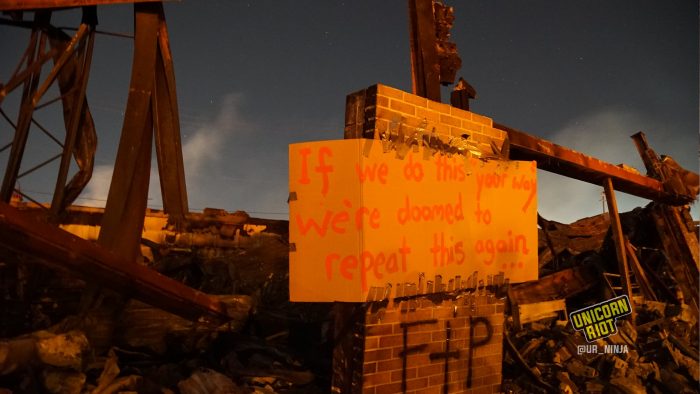
When protesters reached the police precinct home to the officer who has been charged with murdering George Floyd, Unicorn Riot was there.
The “decentralized” and “non-hierarchical” media organization has received attention for its on-the-ground interviews and streams — which have shown viewers the inside of the burning station, police violence, and more. Unicorn Riot is also drawing attention for allowing the protestors to speak, at length, for themselves.
Police have lost all control in South Minneapolis 3 days after their horrific murder of #GeorgeFloyd.
Masses of people have entered the 3rd Precinct, redistributing police equipment and setting fires. We’re live:https://t.co/Qs4rzsNNz4
— Unicorn Riot (@UR_Ninja) May 29, 2020
“Unicorn Riot” is now trending in “United States” – you can support our ongoing coverage here with monthly donations: https://t.co/WQ5SIKseMG
Community support for */years/* led us to be able to cover this moment in depth – Thank you!pic.twitter.com/vKISge6AZm
— Unicorn Riot (@UR_Ninja) May 29, 2020
I think the thing that is most striking to me about these streams – and the thing that it’s reminding me is so sorely lacking from corporate media – is the pure amount of time devoted to listening to the members of the community speak https://t.co/FcULgSiCur
— Becca Lewis (@beccalew) May 29, 2020
If you’re not watching this Minneapolis #GeorgeFloyd livestream, you should be. https://t.co/5ylvvNJxh7
— Jonathan AIbright (@d1gi) May 28, 2020
Unicorn Riot is doing great interviewers with protesters who have taken over the Minneapolis police station https://t.co/dqurYzVbVL
— Peter Sterne
(@petersterne) May 29, 2020
Something the folks on the @UR_Ninja livestream keep emphasizing is how this is an organic movement in Minneapolis – not planned by any particular activist org – but a diverse group of young people who’ve had enough coming together
— Christopher Mathias (@letsgomathias) May 29, 2020
As a profile in the Columbia Journalism Review noted in 2017, Unicorn Riot knows its way around demonstrations, riots, and protests. Its journalists camped in Standing Rock for several “freezing” weeks and drove to cover the alt-right demonstrations in Charlottesville.
Here’s how CJR described its coverage:
Since its founding, Unicorn Riot has gained traction among people looking for alternative news sources, primarily by covering protests with the sort of on-the-ground perspectives many mainstream outlets miss. Unicorn Riot’s coverage is both DIY boot-strap and sophisticated; its news site has an aesthetic somewhere between the “zine”-quality production of many independent news sources and the slick HBO astroturf of an outlet like Vice.
Unicorn Riot is ad- and paywall-free. As a 501(c)(3), it accepts financial support from its audience and grants but reject corporate and government funding, according to its site. (The Minnesota Freedom Fund recently pointed donors in its direction; on Patreon, it’s currently pulling in $3,230 per month.)
The volunteer-led collective operates in Boston, Denver, and Philadelphia, but was founded in Minneapolis. Although Unicorn Riot is relatively young — having first linked up in 2014 — this week’s unrest isn’t its first time covering protests against a police killing in the Twin Cities. Unicorn Riot journalist Niko Georgiades was also on hand to cover the demonstrations that broke out after Jamar Clark was killed by police in 2015. (Ultimately, no charges were filed against the officers involved.)
THREAD: A recent, incomplete history of police murder, protest and resistance in Minnesota’s Twin Cities https://t.co/swuV6sTcuu
— Unicorn Riot (@UR_Ninja) May 27, 2020
During the protests over Clark’s shooting, Georgiades explained the group’s frustration with traditional coverage of activism to Minneapolis Public Radio.
“When it comes to the media’s coverage of the Jamar Clark case,” Georgiades said, “it’s been a continual police report. A police narrative. ‘This is what the police said.'”
News organizations tend to lean on sources like prosecutors or the police for official accounts of what’s happened in crimes, alleged crimes or otherwise. Activists say that, by doing so, news organizations show an inherent bias for government entities and official sources. And in a story in which many people feel that a government entity — the Minneapolis Police Department — is the perpetrator of injustice, that bias is keenly felt.
Back in 2015, Members of Unicorn Riot told MPR that their coverage is unique because they focus on the social movements behind the protests and wind up staying with the story long after other outlets have gone home.
The way its journalists see it, Unicorn Riot is sharing the stories most media don’t. Minority groups are often erased from media coverage, Unicorn Riot members say, and they actively want to change that by seeking out those unheard voices.
College journalism classes preach “giving voice to the voiceless” as a core principle of the job. For the members of Unicorn Riot, most of whom lack formal training in journalism, it’s a given.
Weiland points out the group’s mission statement: “Unicorn Riot’s purpose is to amplify the voices of people who might otherwise go unheard, and broadcast the stories that might otherwise go untold, as we further understanding of dynamic social struggles.”
If you’re wondering what police or institutional sources might say about an issue, Unicorn Riot’s Lorenzo Serna said, go to a legacy news source.
“They have a giant voice already,” he said.
As for the name? Unicorn Riot “doesn’t stand for anything in particular.” The founders just liked the way it sounded.